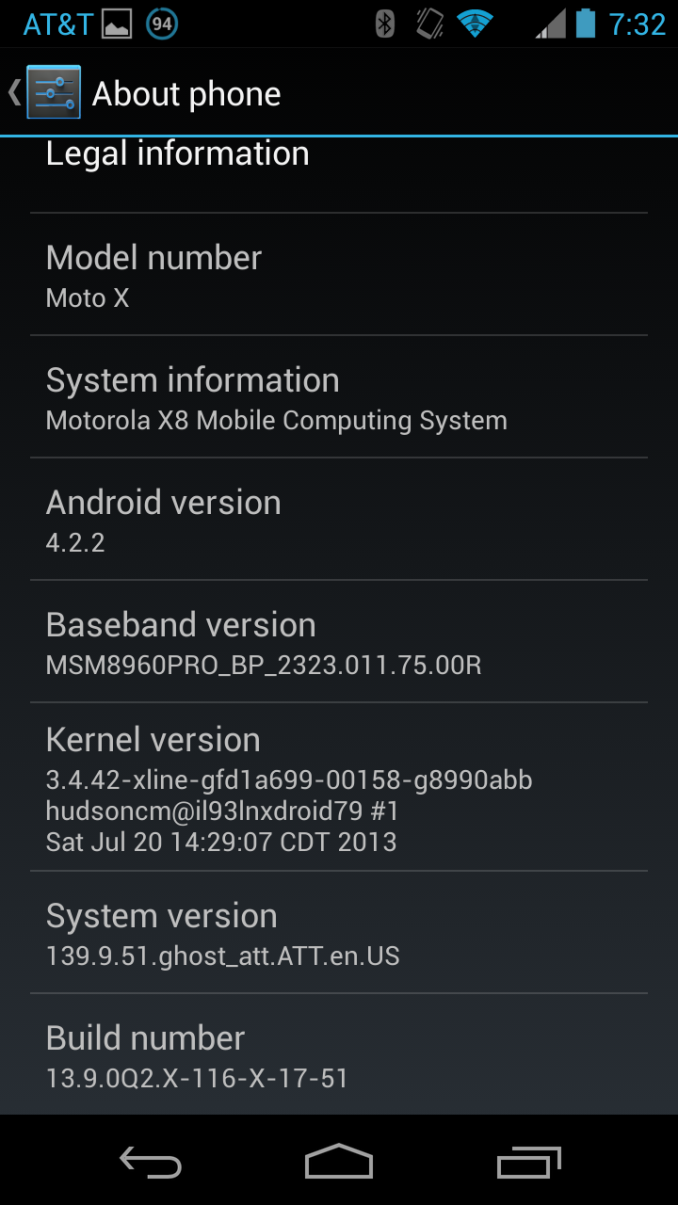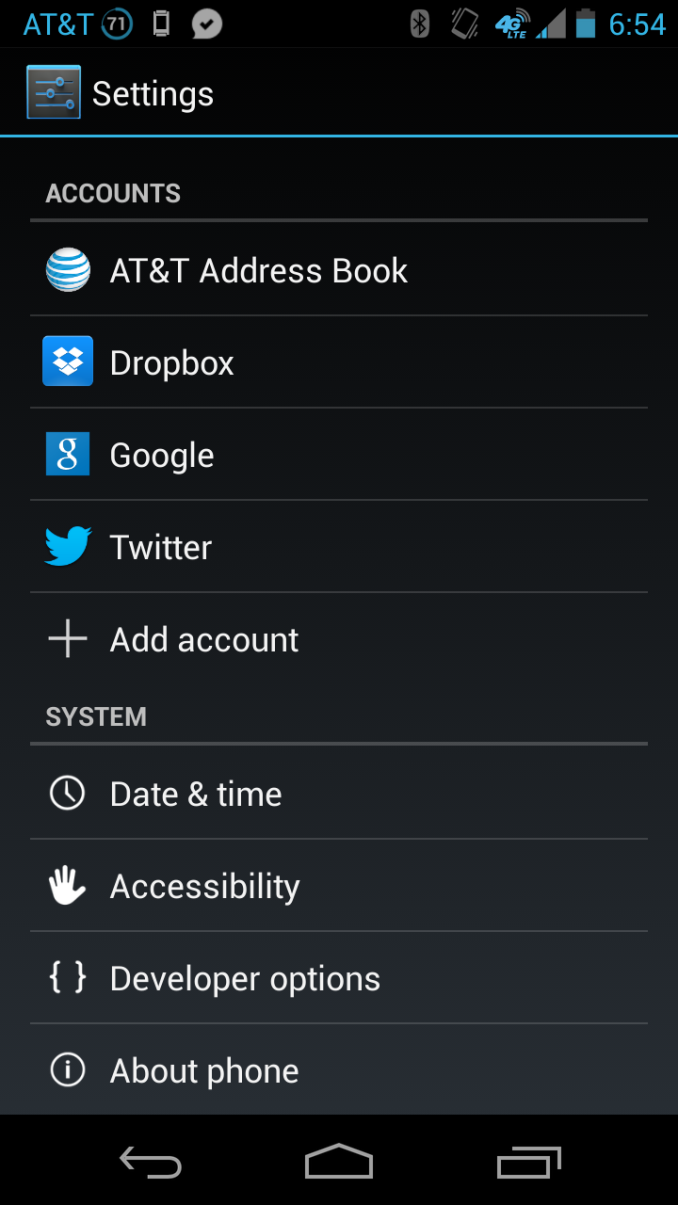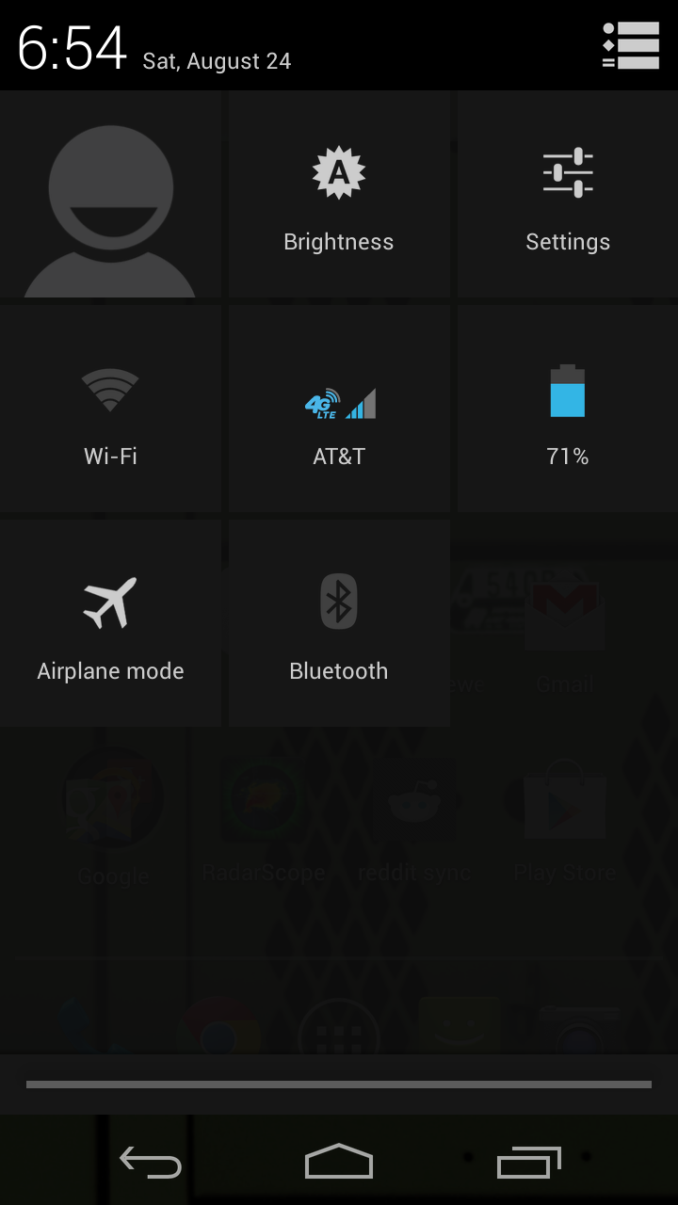Moto X Review
by Brian Klug on August 26, 2013 1:30 PM EST- Posted in
- Smartphones
- Qualcomm
- MSM8960
- Motorola
- Android
- Mobile
- Android 4.2
- Moto X
Somewhat Stock Android
One of the first things that changed for Motorola under its new Google ownership was the final nail through the coffin for Motoblur, with OTA updates for some of its handsets gradually scaling back customized features in favor of stock ones. I joked with Anand that Google paid $12.5 billion for Motorola just to kill the beast that was Motoblur. Truth be told the presence of largely-stock Android 4.x UI is perhaps one of the best qualities of the Moto X.
ro.build.version.full=Blur_Version.139.9.51.ghost_att.ATT.en.US
The Moto X at launch runs Android 4.2.2, which isn’t quite bleeding edge Android, but close. This is essentially an intentional side effect of the Google / Motorola firewalling that we’ve been told is in place. I’m not entirely surprised, but I had hoped the Moto X would differentiate itself by somehow launching with 4.3 considering other handset partners had the Jelly Bean MR2 (4.3) update a while ago, clearly Motorola should’ve as well. I know that Qualcomm had the BSP (Board Support Package) for 4.3 ready for MSM8960Pro at the same time as it did APQ8064, so I can’t think of any technical reason. Again I’d wager Moto X launching with 4.2.2 is entirely political, to say nothing of the usual operator testing nonsense in the USA.
Anyhow the homescreens (widget panels), launcher, settings menu, notification shade, dialer, and default applications are basically unadulterated Android. I say largely unadulterated because to say that the Moto X is entirely stock is still not quite true – there’s the operator name in the top left of the notification bar all the time, and the branded network status indicator (the cartoonish looking AT&T “4G” and “4G LTE” logos) on my AT&T unit. Unnervingly, the network status logo and bars are also a different shade of blue than the battery and time icons adjacent to it.
There’s also AT&T address book preloaded which cannot be removed, which is a huge annoyance. There’s also a provisioning check for bluetooth and WiFi tethering, another indication of an operator-touched device. There’s also AT&T my Wireless and AT&T’s visual voicemail app loaded, but those are pretty understandable.
The Moto X also has a few UI changes that definitely aren't stock. The status bar has different spacing for the cellular and WiFi indicator logos which carries over as a result of Blur (the spacing issue is just the "4G LTE" or similar status logo disappearing when on WiFi). Also the on-screen android buttons sometimes appear transparent, showing what's under, which definitely isn't a stock implementation.
My definition of stock is just that, totally stock – no branded logos, operator names everywhere, or any preloaded apps. Truth be told the Moto X isn’t stock, it just has the stock UI on top of a relatively standard Motorola software build, but it does have a heck of a lot less of the operator preload crapware that normally shows up on Android phones sold with a subsidy these days. Android’s visual style is now mature and appealing enough that it really doesn’t need customization or modification to look good, rather it just needs to be left alone as much as is politically possible. If there’s one thing the Moto X does that every other handset maker should take to heart, it’s exactly that.
If you’re on a wireless operator that can’t work with the newest Nexus phone or Google Play edition devices (like the CDMA ones in the USA – Verizon, Sprint, US Cellular), the Moto X might be the closest you can get to stock, even if it technically isn’t completely so. I suspect this will attract a lot of enthusiasts who are on other operators for their own reasons, even if the longer term solution really should be to vote with your wallet and move to an operator that’s open and compatible with those devices.














105 Comments
View All Comments
SomeGuyonaBike - Tuesday, August 27, 2013 - link
I understand and agree with general objections to carrier-installed bloatware (and because of this I won't decide whether or not to buy a carrier-branded X until details about the developer editions are public)... I'm just curious as to why reviewers are so negative about this particular piece of carrier bloat.Impulses - Tuesday, August 27, 2013 - link
I think I disabled it on my sister's One X, wasn't really an issue...SomeGuyonaBike - Tuesday, August 27, 2013 - link
I spent a few minutes playing with a demo unit at an AT&T store over the weekend. When I launched the "People" app it wanted to sync to an AT&T address book, but there was an option to decline. I wonder if opting out of using the AT&T address book is a permanent thing, or if you have to repeat the opt-out every so often.Tralio - Wednesday, September 11, 2013 - link
AT&T address book is a bit of an annoyance for everyday use, even on the X it tends to open incredibly slow. On the other hand when switching to my X it imported all my contacts onto my device without needing to import from sim. This can be an issue when switching from some of motorola or other developers' older models with larger sims, especially with the X not having an sd card slot and not every user knowing they can import/export from their comp. On a side note though for at&t users (not sure about the rest of the carriers) all at&t stores have a sim cutter that they can cut your sim down to the smaller size if you'd prefer to import from your current sim card or just don't want to deal with activating the new one.jasperjones - Monday, August 26, 2013 - link
Brian,I agree that smartphone line out/headphone out sound quality is still a bit of a challenge. Looking forward to your new audio test suite. It would be great if you guys could report RMAA results.
Brian Klug - Monday, August 26, 2013 - link
I like RMAA, but it's easy to get a lot of things wrong and isn't really mobile workflow friendly. We're going to try something different that's a lot more robust :)-Brian
synaesthetic - Friday, September 6, 2013 - link
The thing I would like most, that I can't seem to find anywhere for any smartphone, and something that affects audio quality with headphones to a greater degree than any other attribute...Output impedance.
Please, for the love of all that is holy, why can't at least one device reviewer measure the output impedance of these phones?!
cheinonen - Monday, August 26, 2013 - link
I should find out this week if I'll have access to a new suite of tests or not. If I can do it, RMAA will look like child's play in comparison. Believe me, we're looking forward to it.Impulses - Tuesday, August 27, 2013 - link
Are you gonna go back and test at least this year's flagships? It'd be nice to have a baseline, particularly since this is something manufacturers have supposedly emphasized (HTC with the One, LG with the upcoming G2).cheinonen - Tuesday, August 27, 2013 - link
It looks like I'll have access to some new testing methods, but it will be a month or so until I can do them all probably (sorry, I have a large backlog of other things to get done right now). I'll plan to do a huge initial round-up of phones and tablets to get a baseline and create an article about the new tests. I also want to point out that audio tests might not run with the initial phone tests since Brian or anyone else will have to ship the phones to me in Oregon to test and it'll take them out of the hands for a few days.We haven't tested this yet, but we're hoping it really helps us set a standard for audio testing of phones and tablets.